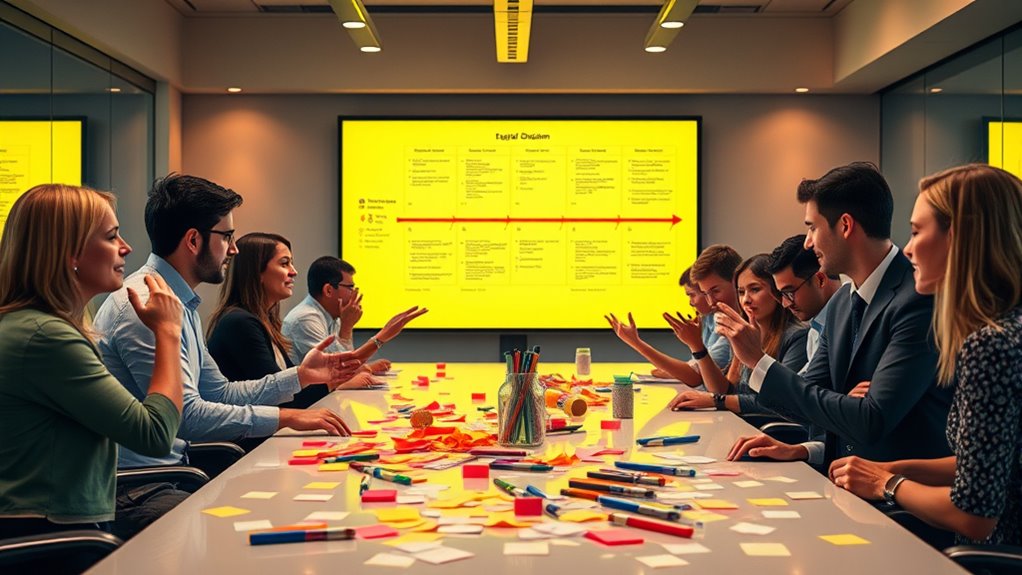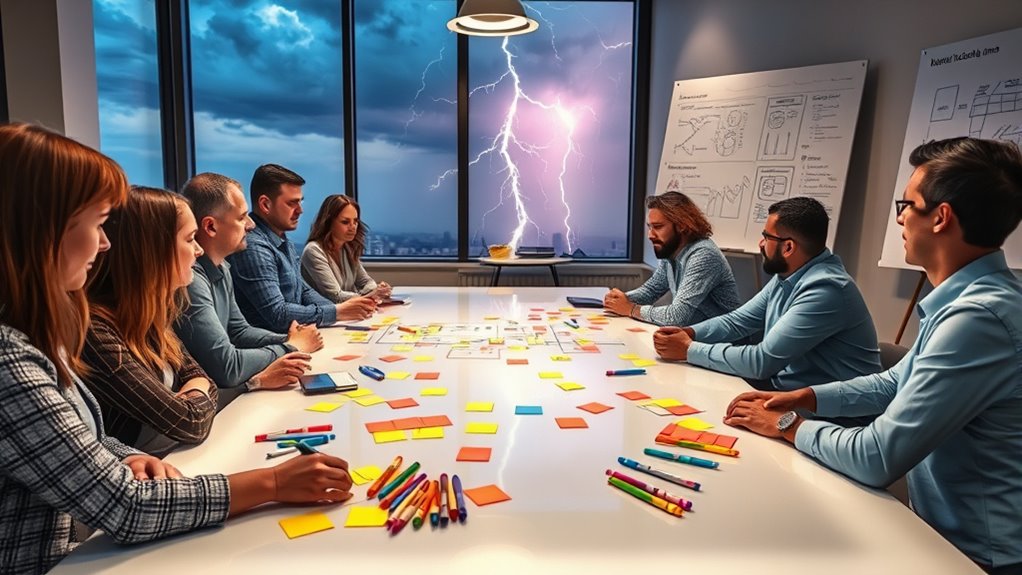Lightning Decision Jams are fast-paced, 60-minute workshops you can use to replace long, unproductive meetings. They help you quickly gather input, clarify decisions, and promote collaboration all in one focused session. By following a structured approach—defining goals, brainstorming solutions, and voting—you’ll keep participants engaged and prioritize impactful actions. Ready to learn how to run a successful Lightning Decision Jam and transform your meetings? Keep going to discover how to make it work for your team.
Key Takeaways
- Lightning Decision Jams are structured 60-minute workshops designed to quickly gather input and make decisions, replacing lengthy meetings.
- They focus on clear problem framing, diverse idea generation, and prioritization through voting, streamlining decision-making processes.
- Facilitators guide participants through activities like brainstorming, categorizing issues, and selecting impactful actions efficiently.
- These workshops promote open communication, equal participation, and rapid consensus, reducing delays and confusion.
- Implementing Lightning Decision Jams enhances team alignment, accelerates action, and minimizes wasted time spent in traditional meetings.
Understanding the Purpose of Lightning Decision Jams

Lightning Decision Jams are designed to quickly gather input and make decisions within a team or organization. Their main purpose is to improve decision making clarity by focusing on key issues and avoiding unnecessary delays. When you run a Lightning Decision Jam, you create a structured environment that fosters open communication and encourages everyone to share their perspectives. This process helps align your team around common goals, ensuring everyone understands the priorities and the rationale behind decisions. Unlike lengthy meetings, these jams cut straight to the point, saving time while boosting team alignment. By streamlining decision-making, Lightning Decision Jams empower you to act faster, reduce confusion, and foster a collaborative atmosphere where everyone’s voice is heard. Incorporating clear decision-making processes enhances the effectiveness of these workshops and ensures sustained improvements in team dynamics.
Setting Up a Successful Workshop

To set up a successful Lightning Decision Jam workshop, start by clearly defining your objectives and identifying the key issues you want to address. Guarantee team alignment by communicating these goals upfront, so everyone knows what’s expected. Engage stakeholders early, inviting their input to foster buy-in and diverse perspectives. Prepare materials and set a clear agenda to keep the session focused and efficient. Choose a neutral facilitator to guide the process and maintain neutrality. Make sure the environment encourages openness and collaboration. Incorporating diverse designs and materials can also inspire creative solutions and energize participants. By aligning your team and involving stakeholders from the outset, you create a foundation for productive discussions and quick decision-making. This preparation sets the stage for a workshop that’s focused, engaging, and effective at solving problems.
Key Activities and Structure of a Lightning Decision Jam

A Lightning Decision Jam typically unfolds through a series of structured activities designed to quickly identify problems, generate solutions, and prioritize actions. You start with framing the challenge and gathering insights from participants. Then, you use brainstorming techniques to generate ideas efficiently, encouraging everyone to contribute without judgment. Clear participant roles help keep the process smooth: a facilitator guides the session, while team members contribute ideas and vote on priorities. Next, you categorize issues, identify root causes, and brainstorm possible solutions. Incorporating effective preparation ensures that the session runs seamlessly and achieves its objectives. Finally, the group votes on the most impactful actions to take. This structured flow ensures you make fast, focused decisions. The activities are designed to maximize input, foster collaboration, and produce actionable results—all within a tight timeframe.
Tips for Facilitating Engaging and Productive Sessions

Creating an engaging and productive session starts with clear preparation and setting the right tone. Begin with icebreaker activities to build rapport and encourage participation early on. These quick exercises help everyone feel comfortable and ready to contribute. Effective time management is essential—set strict time limits for each activity and adhere to them to keep the session focused. Use visual cues or timers to remind participants of time constraints. As facilitator, stay attentive, redirect conversations that drift off-topic, and ensure quieter voices are heard. Keep energy levels high with dynamic activities and encourage open, respectful dialogue. Additionally, understanding how contrast ratios influence image quality can inspire creative approaches to maintaining engagement and clarity during discussions. Ultimately, your goal is to craft an environment where ideas flow freely, and participants leave feeling accomplished and motivated to act.
Common Challenges and How to Overcome Them

Many facilitators encounter common challenges during sessions, such as participants dominating conversations, side conversations, or a lack of engagement. These issues can hinder team alignment and stall progress. To overcome them, set clear ground rules at the start, encouraging equal participation. Use structured activities that give everyone a voice, helping to maintain focus and reduce side chatter. If engagement wanes, shift the activity or ask targeted questions to re-engage participants. Ensuring stakeholder involvement is essential; you might assign specific roles or use visual aids to make everyone feel involved. Regularly monitor the room’s energy and intervene early when disruptions occur. Addressing these challenges promptly helps keep the session productive, fosters alignment, and guarantees all stakeholders are actively contributing. Developing Cultural Intelligence within the team can also improve understanding and cooperation, reducing misunderstandings during collaborative sessions.
Examples of Problems Solved With Lightning Decision Jams

Lightning Decision Jams (LDJs) quickly resolve complex problems that require input from diverse stakeholders. For example, you can use an LDJ to achieve stakeholder alignment on project priorities, ensuring everyone shares a common vision. They’re also effective for clarifying resource allocation, helping teams decide how to distribute limited resources efficiently. When your team faces conflicting opinions or unclear priorities, an LDJ facilitates rapid consensus. It’s ideal for addressing strategic decisions, such as selecting new tools or adjusting workflows, without the lengthy debates typical of traditional meetings. By involving key stakeholders in a focused session, you streamline decision-making, reduce ambiguity, and foster buy-in—all within 60 minutes. These workshops turn complex challenges into actionable solutions, saving time and enhancing team cohesion.
Measuring Success and Next Steps After the Jam

After completing a Lightning Decision Jam, establishing clear metrics to evaluate its success is vital. Success metrics help you determine if the workshop achieved its goals and guide future actions. Incorporate feedback loops by gathering input from participants about what worked and what didn’t, guaranteeing continuous improvement. Track tangible outcomes like decisions made, assigned tasks, or process changes implemented. Additionally, consider qualitative feedback to assess team alignment and engagement. Next steps involve analyzing these success metrics, identifying gaps, and planning follow-up actions. Communicate findings transparently to maintain momentum and accountability. By measuring success carefully, you turn a quick workshop into a powerful tool for ongoing progress and innovation. This approach ensures each Jam leads to meaningful, measurable results. Incorporating market research strategies can further refine your approach and ensure alignment with your overall goals.
Frequently Asked Questions
How Long Does It Typically Take to See Results After a Lightning Decision Jam?
You might see some initial results within days, but the full implementation timeline depends on your team’s immediate actions. Typically, measurable outcomes become apparent within a few weeks as ideas are put into practice. By staying engaged and tracking progress, you’ll notice progress faster. Lightning Decision Jams help streamline decision-making, so expect quicker results compared to traditional meetings, often within the first month, fostering momentum toward your goals.
Can Lightning Decision Jams Be Adapted for Remote or Hybrid Teams?
Imagine your remote team uses virtual collaboration tools to brainstorm ideas quickly. Lightning Decision Jams easily adapt by leveraging video calls, shared digital boards, and chat apps for seamless tech adaptation. These tools foster active participation, ensuring everyone’s voice is heard, even from afar. You can run effective sessions, making decisions swiftly without physical presence, boosting productivity and engagement in hybrid or fully remote settings.
What Industries Benefit Most From Implementing Lightning Decision Jams?
You’ll find that industries like manufacturing and healthcare benefit most from lightning decision jams. These quick workshops boost manufacturing efficiency by streamlining problem-solving and decision-making, reducing downtime. Healthcare innovation also thrives, as teams rapidly brainstorm solutions for patient care or operational issues. By adopting these 60-minute sessions, you’ll see faster results, clearer communication, and more agile responses—making them a valuable tool across fast-paced, results-driven sectors.
Are There Any Common Misconceptions About Lightning Decision Jams?
Like flickering candle flames in a storm, misconceptions about lightning decision jams can cause confusion. You might think they’re just quick fixes, but the truth is, clear understanding reduces misinterpretation risks. Some assume they replace all meetings, but they’re meant to streamline decision-making, not eliminate collaboration. Gaining clarity on their purpose helps you avoid misjudging their value, ensuring you use them effectively to accelerate progress without sacrificing quality.
How Do You Handle Dominant Personalities During the Workshop?
You handle dominant personalities by setting clear ground rules at the start of the workshop to guarantee everyone gets a voice. Use structured activities to balance participation, and gently redirect dominant individuals if they monopolize the conversation. Keep the focus on workshop dynamics, encouraging quieter team members to share their ideas. By fostering an inclusive environment, you make certain productive discussions and prevent dominant personalities from overshadowing others.
Conclusion
Lightning Decision Jams can transform your team’s approach to problem-solving, replacing lengthy meetings with focused, 60-minute sessions. Did you know teams that use these workshops see a 30% boost in decision-making speed? By mastering the setup, fostering engagement, and addressing challenges, you’ll unleash quicker solutions and clearer collaboration. Embrace this proven method to save time and energize your team—your productivity and results will thank you.









